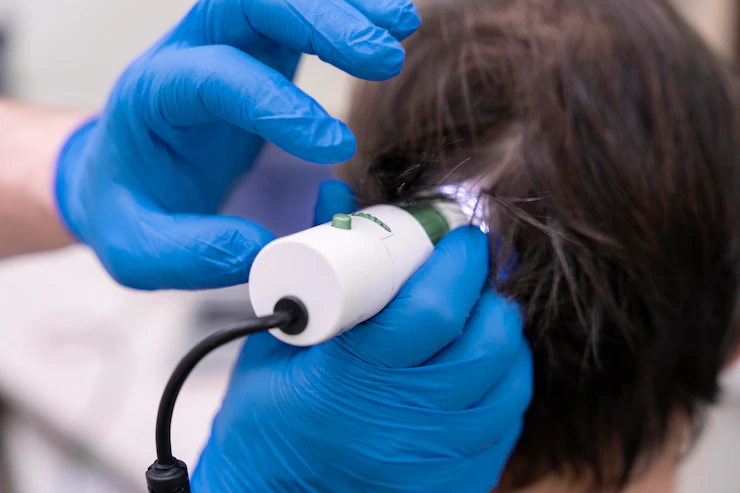HAIR LOSS TREATMENT
Hair grows everywhere on the human skin except, on places like the palms of our hands and the soles of our feet, our eyelids and belly buttons, but many hairs are so fine they’re virtually invisible.
Hair is made of a protein called keratin that is produced in hair follicles in the outer layer of skin. As follicles produce new hair cells, old cells are being pushed out through the surface of the skin at the rate of about 6 inches a year. The hair you can see is actually a string of dead keratin cells. The average adult head has about 100,000 to 150,000 hairs and loses up to 100 of them a day; finding a few stray hairs on your hairbrush is not necessarily cause for alarm.
At any time, about 90% of the hair on a person’s scalp is growing. Each follicle has its own life cycle that can be influenced by age, disease, and a wide variety of other factors.

This life cycle is divided into three phases:
- Anagen: active hair growth that generally lasts between 2 to 8 years
- Catagen: transitional hair growth that lasts 2 to 3 weeks
- Telogen: resting phase that lasts about 2 to 3 months; at the end of the resting phase the hair is shed and a new hair replaces it, and the growing cycle starts again.
There are many types of hair loss, also called alopecia:
- Involutional alopecia is a natural condition in which the hair gradually thins with age. More hair follicles go into the resting phase, and the remaining hairs become shorter and fewer in number.
- Androgenic alopecia is a genetic condition that can affect both men and women. Men with this condition, called male pattern baldness, can begin having hair loss as early as their teens or early 20s. It’s characterized by a receding hairline and gradual disappearance of hair from the crown and frontal scalp. Women with this condition, called female pattern baldness, don’t have noticeable thinning until their 40s or later. Women experience a general thinning over the entire scalp, with the most extensive hair loss at the crown.
- Alopecia areata often starts suddenly and causes patchy hair loss in children and young adults. This condition may result in complete baldness (alopecia totalis). But in about 90% of people with the condition, the hair returns within a few years.
- Alopecia universalis causes all body hair to fall out, including the eyebrows, eyelashes, and pubic hair.
- Trichotillomania, seen most frequently in children, is a psychological disorder in which a person pulls out their own hair.
- Telogen effluvium is temporary hair thinning over the scalp that occurs because of changes in the growth cycle of hair. A large number of hairs enter the resting phase at the same time, causing hair shedding and subsequent thinning. Learn more about what causes telogen effluvium.
- Scarring alopecias result in permanent loss of hair. Inflammatory skin conditions (cellulitis, folliculitis, acne), and other skin disorders (such as some forms of lupus and lichen planus) often result in scars that destroy the ability of the hair to regenerate.
- Traction alopecia. Hot combs and hair too tightly woven and pulled can also result in permanent hair loss.
- Central centrifugal cicatricial alopecia. This is the most common type among Black women. This often manifests as a small bald patch in the center of the scalp that grows over time.
Hair Loss Causes
Doctors don’t know why certain hair follicles are programmed to have a shorter growth period than others. However, several factors may influence hair loss:
- Hormones, such as abnormal levels of androgens (male hormones normally produced by both men and women)
- Genes, from both male and female parents, may influence a person’s predisposition to male or female pattern baldness.
- Stress, illness, and childbirth can cause temporary hair loss. Ringworm caused by a fungal infection can also cause hair loss. Learn what you can do to help reverse hair loss caused by stress.
- Drugs, including chemotherapy drugs used in cancer treatment, blood thinners, beta-adrenergic blockers used to control blood pressure, and birth control pills, can cause temporary hair loss.
- Burns, injuries, and X-rays can cause temporary hair loss. In such cases, normal hair growth usually returns once the injury heals unless a scar is produced. Then, hair will never regrow.
- Autoimmune disease may cause alopecia areata. In alopecia areata, the immune system revs up for unknown reasons and affects the hair follicles. In most people with alopecia areata, the hair grows back, although it may temporarily be very fine and possibly a lighter color before normal coloration and thickness return.
- Cosmetic procedures, such as shampooing too often, perms, bleaching, and dyeing hair can contribute to overall hair thinning by making hair weak and brittle. Tight braiding, using rollers or hot curlers, and running hair picks through tight curls can also damage and break hair. However, these procedures don’t cause baldness. In most instances hair grows back normally if the source of the problem is removed. Still, severe damage to the hair or scalp sometimes causes permanent bald patches.
- Medical conditions. Thyroid disease, lupus, diabetes, iron deficiency anemia, eating disorders, and anemia can cause hair loss. Most times, when the underlying condition is treated, the hair will return unless there is scarring as in some forms of lupus, lichen planus, or follicular disorders.
- Diet. A low-protein diet or severely calorie-restricted diet can also cause temporary hair loss. Get information about foods that can help prevent hair loss.
- Vitamin deficiencies. Deficiencies in vitamins A, B, C, D, and E, as well as iron and zinc, have been associated with hair loss.
FAQs:-
It is normal to lose about 100 – 150 hair strands every day.
This depends on the amount of the stress you’re experiencing and how much effect it has on the normal functions of your body. Normally, the mild stress we experience on a day-to-day basis is not enough to cause hair loss. However, severe stress that is a result of serious or traumatic events, such as divorce, a drastic change in diet, surgery, or extreme weight loss, may cause a physiological imbalance in your system. This physiological change often leads to hair loss because it “shocks” your body’s normal routine. Thus, many of its natural functions are disrupted, which includes your natural hair cycle. The sudden physiological changes in your body may trigger a larger amount of hairs on your head to go into a “resting phase”, and thus it may seem that you’re only losing hair and that there is no growth.
The act of shampooing merely only loosens hair that is about to fall out. Excessive hair styling may weaken or damage hair, and lead to hair breakage. However, both methods have not been proven to be direct, underlying causes for hair loss.
Hair loss is an extremely common occurrence and affects most people in varying degrees at some point in their lives. Hair loss can occur due to one or a mix of the following: severe stress, genetics, illnesses such as thyroid disease and anemia, nutritional changes, hormonal changes related to puberty, pregnancy and menopause, vitamin D deficiency, or side effects of strong medication (such as chemotherapy).
Hair thinning in male pattern hair loss can be attributed in a percentage of males to genetics and hair follicle sensitivity to dihydrotestosterone (DHT). Female pattern hair loss which has similarities to male pattern hair loss in terms of miniaturization of hair follicle has no known cause.
REACH US
2-37/74&75/2 CROWN COURT, 2nd FLOOR, PLOT NO: 74 & 75 VINAYAK NAGAR, GACHIBOWLI, HYDERABAD-500032.
